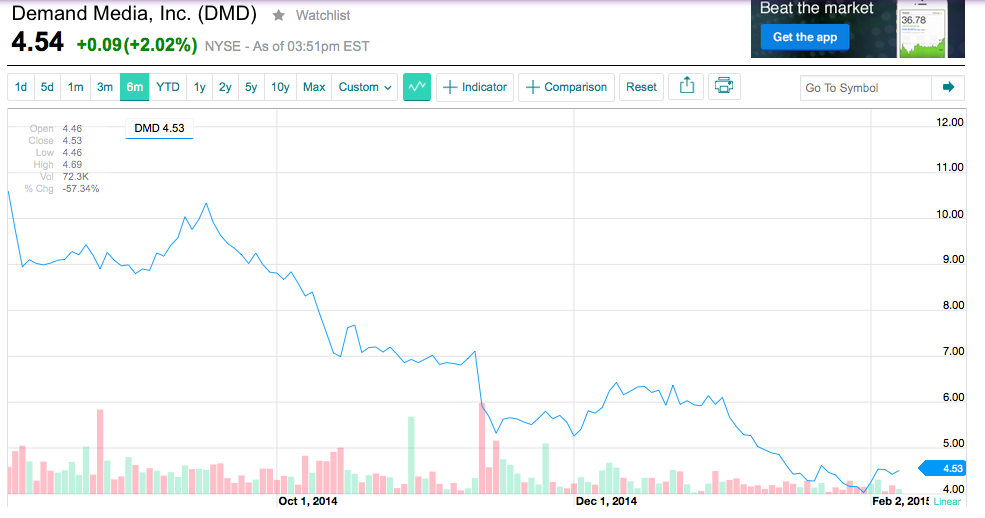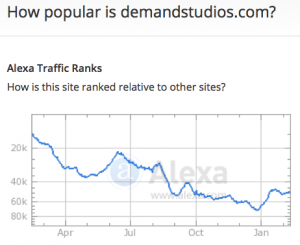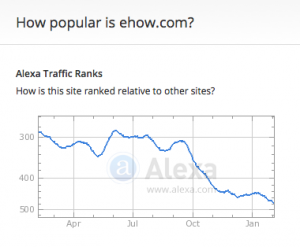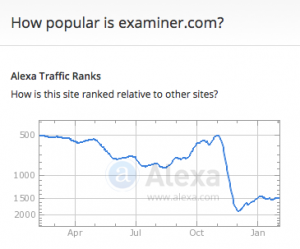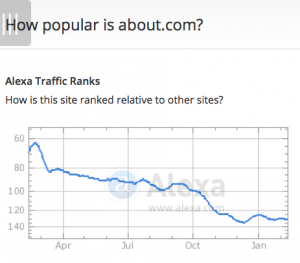 Remember what it was like to write online content in 2006? Back then, there was a ton of opportunity for writers willing to crank out boatloads of hastily written, low-paid content for content mills.
Remember what it was like to write online content in 2006? Back then, there was a ton of opportunity for writers willing to crank out boatloads of hastily written, low-paid content for content mills.
These sites got a ton of traffic off the key words in their posts. Visitors would click the ads they put on those pages, and the sites could make a fortune.
One of the most successful pioneers of this mass-content model was Demand Studios. When its parent company, Demand Media, went public in 2011, there was a brief moment when Demand was worth more than the New York Times.
Those days are long gone. Google soon got hip to the lack of value to online readers of most content-mill writing. It started changing its algorithm to exclude such sites from its search results. (When’s the last time you got a link to eHow on page one of a Google search? Yeah.)
The company’s founder and CEO quit in October 2013, having pocketed his millions from the stock offering.
If you’ve been wondering what’s happened since, let me give you a content mill update here.
The short version: Mass SEO-focused content sites are in a death spiral. If you earn much of your money writing for mills or big revenue-share sites, you need a new game plan.
The shift from quantity to quality
In its fight to stay the top search engine, Google has moved aggressively to make sure its search results remain highly useful. That’s created a sea change in what’s important in online writing.
Now, you can have huge traffic on your site and a ton of content, but if that content isn’t highly useful, you may still not end up with a profitable site. Readers don’t stay, and they increasingly don’t click on ads, anyway.
All the websites that depend on this model — mass content to get ad clicks — are in terrible trouble. If you’ve noticed a downturn in how many mill assignments are available, or that pay is getting smaller, there’s a reason.
Content mills don’t make money, so they can’t pay you any, either.
Charting the decreasing Demand
Let’s look at what’s happened to investors’ feelings about Demand Media since it went public in fall 2011 at $17 a share. Yes, it’s just one content mill, but one of the biggest survivors (Associated Content merged into Yahoo! and then shut down last year, for instance). You can extrapolate that if things are going wrong at Demand, other mills with a similar business model are experiencing the same thing.
Back when, Demand investors thought this was an exciting, disruptive business that was going to transform publishing forever. On its debut, the stock shot up. But here’s what their stock has done in the past six months:
Why is Demand worth so much less than before? Because traffic is shrinking, and revenue and profits are vaporizing as a result. As of the end of September (freshest data available), Demand had made $108 million in 2014 — and declared a loss on that of nearly $250 million.
By contrast, Demand made over $158 million in the same period in 2013, and its loss was under $9 million. It was a struggling company then. Now, it’s an imploding company.
Why the impressive losses? Simple: Less traffic.
Here are traffic charts for Demand Studios and its eHow site from Alexa:
(Yes, I know Alexa isn’t super-accurate, but these charts are looking similar on SEMRush and other tools, too.)
Notice how those declining traffic curves resemble the stock-price chart? That’s because as traffic goes down on an ad-based site, less money comes in. A lot less. That means the stock is worth less, too.
To sum up, if you cleared $100 from your blog last year, you netted more than Demand Studios. If you ever wondered why content mills don’t pay writers more, it’s because even paying you a pittance, they’re not making a profit.
Closing time
What happens when a company loses that much money? Cutbacks and desertions. At Demand, a couple months after the bad loss news came out last fall, it meant the company closed all their foreign offices and stopped assigning articles for their non-English websites.
And this month, more executives jumped ship to other, more stable companies. When people with inside information, who’re earning a good salary inside a company, are stampeding out the door — leaving a company that probably gave them stock options — you know the outlook isn’t good.
Look back far enough, and you’ll see this was always a pipe dream. Demand only made a profit in one of the past five years, and it was a pittance compared to the losses they’ve racked up. Masses of garbage content driving ad revenue was never a business — it was a theory that didn’t pan out.
And Demand knows it. That’s why they now own ecommerce marketplaces Society6, Pluck, and Saatchi Art.
They’re diversifying. Moving on to other types of business that make money. Are you?
It’s not just Demand
In case you think plummeting traffic is just a problem at this particular content mill, and you could simply flee to some other mass-content platform that’s still doing well, let me show you a couple other traffic charts.
These sites aren’t mills, but also make their revenue off ads placed on masses of quickie content:
An era is ending here, both for these sites, and for writers reliant on income from them.
Quickly written articles that are mostly SEO fodder for search-engine robots to read don’t work anymore. In the future, you can expect there to be less and less opportunity to write these, and less and less pay for whatever assignments of this type remain.
The main takeaway: This downturn in traffic on mass quick-content sites is not a fad, a fluke, or a momentary aberration. It’s a downward spiral that will not be reversed. Google continues to update its algorithms, on a mission to exclude these sorts of sites from search results.
Writing for content mills is a dying occupation.
The good news for writers
This may be upsetting news, if you are currently earning a decent portion of your income from content mills.
But there is an enormous silver lining.
With the fall of junk mass content comes the rise of in-depth, high-quality content that readers find super-useful. Companies will still use content to get visitors to their sites, because it’s way cheaper and more effective than traditional advertising.
If you can write it, there is going to be ample opportunity to earn well online in the coming years. Coming up, companies will be competing to post the most valuable content possible on their sites. Because that’s how businesses get traffic, find new customers and make sales.
It’s time to stop signing into a content-mill dashboard, and learn how to prospect and find better clients. They’re the ones who’ll be hiring writers for fat, better-paying content projects in the months and years to come.
What’s your prediction for the future of content mills? Share your take in the comments.







